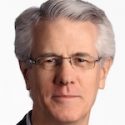Stage set for WID’s Town Center to welcome visitors
It won’t open until December, but the Town Center now under construction within the Wisconsin Institutes for Discovery is already sharing its plans for engaging citizens with world-class science.
From embedded teaching labs that will host school groups to interactive displays focusing on discoveries in virology, tissue engineering, home health care, stem cells and other fields, the Town Center will serve as a hub of activity. Unusual physical elements including water walls, hands-on technology kiosks and an indoor garden with plant species reminiscent of the dinosaur age all were highlighted Thursday at a series of preview sessions on the UW–Madison campus.
The preview sessions at Memorial Union drew approximately 1,000 attendees who came to learn more about the project, which has been more than three years in the making. Event sponsors include: Ballinger; MG&E; M&I Bank; ZEBRADOG; BlueBean; Corning Life Sciences; Findorff|Mortenson, a Joint Venture; Life Technologies; Neckerman Insurance Services; McGladrey & Pullen; Solheim Billing & Grimmer; Uihlein-Wilson Architects; and Venture Investors.
“The Town Center is designed to inspire collaboration and create connections among university scientists, business and cultural leaders and community members,’’ says Laura Heisler, director of programming for the Wisconsin Alumni Research Foundation, a supporter of the project. “It’s going to be a hub of activity for scientists within the Wisconsin Institutes for Discovery, university faculty, staff, school teachers and students as well as members of the business community and broader community.’’
To achieve its vision as a place to gather, share ideas and celebrate science, creativity and discovery, Heisler said the Town Center has been designed with unique physical features that encourage interaction. Among them:
- The Forum, where walls retract upward and space opens or contracts according to the needs of presenters, conference and exhibition planners and discussion group leaders.
- Varied food venues in three locations in the Town Center named after legendary UW–Madison scientists. The options include a café and bakery, Aldo’s Cafe; a soda fountain and dairy bar, DeLuca’s Dairy Bar; and a restaurant and bar, Steenbock’s on Orchard. All three are available to the public and designed to highlight regionally grown, freshly prepared and affordable foods.
- Discovery niches that permit hands-on activities for visitors of all ages during planned events and casual visits. The niches support a variety of options including microscopes, live demonstrations and touch-screen computers.
- Embedded teaching labs on floors two, three and four that offer space for specialized instruction in biology, computation and the physical sciences. The labs may be used for student enrichment, teacher training, technology demonstrations and more.
- Unusual architectural and interactive elements including water walls, indoor gardens with plants reminiscent of the dinosaur age, technology kiosks and interactive installations.
Heisler says the Town Center’s unique capabilities already have drawn the attention of science and technology organizations as well as cultural groups seeking ways to link science, art and the humanities. Along with Union South, which is under construction directly across Campus Drive, the Town Center will host the National Science Olympiad Tournament in May 2011. The Town Center also will host a reception for the Small Business Innovation Research National Conference scheduled for April 2011 at the Monona Terrace Convention Center.
Yet beyond its ability to host events and introduce citizens to groundbreaking science, Heisler says the Town Center fills an important role by advancing the strategic goals of UW–Madison and WARF.
“As a crossroads of creativity, culture and innovation, the Town Center will further the university’s efforts to provide an exemplary undergraduate education and extend the benefits of campus research to the people of Wisconsin and beyond,’’ she says. “At the same time, we recognize the critical role of the private sector and the Town Center will provide a focal point for business acceleration activities and entrepreneurial interactions.’’
Set in the heart of the UW–Madison campus on the 1300 block of University Avenue, the Town Center links the private Morgridge Institute for Research with the public Wisconsin Institute for Discovery. Made possible with support from private donors John and Tashia Morgridge, UW–Madison, the state of Wisconsin and WARF, the facility is set to open Dec. 2, 2010. For more, visit www.discovery.wisc.edu.

